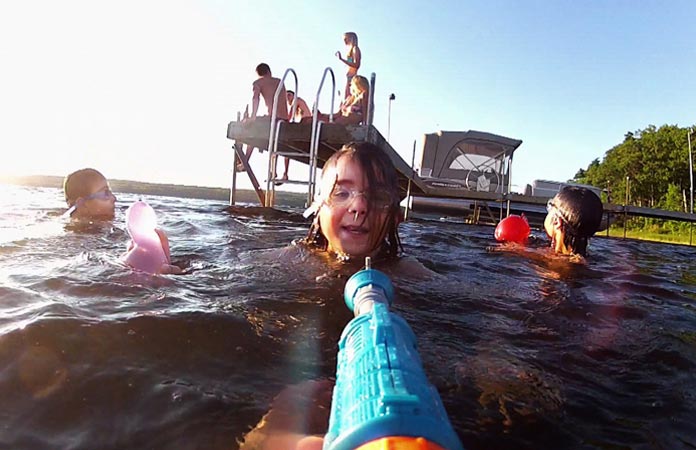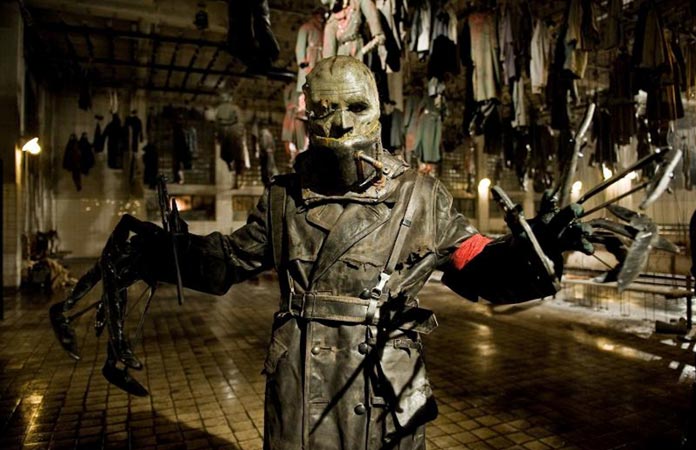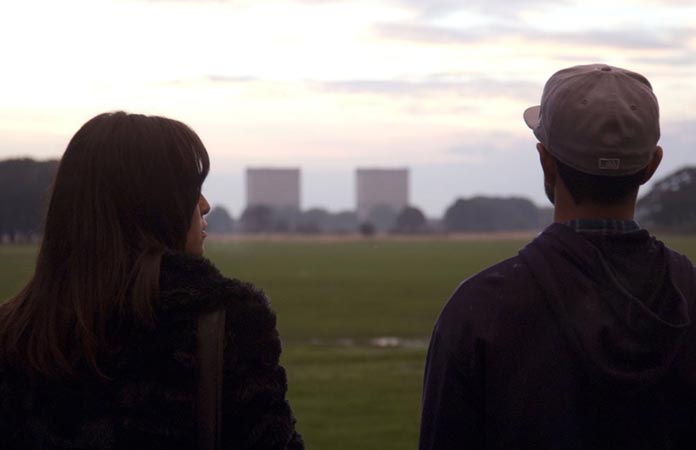DVD Review: V/H/S/2
Published on September 28th, 2013 in: Current Faves, DVD, DVD/Blu-Ray Reviews, Found Footage, Horror, Movie Reviews, Movies, Reviews |Here’s a fun experiment to try! Sit ten people around a campfire on a moonless night and start telling scary stories. Everyone takes a turn. What you’ll find quickly enough is that not everything scares everybody. One person may be frightened by ghost stories. Another may be terrified of demonic possession tales. One never knows.
That’s the joy—and the potential for failure—found within any horror anthology film. They’re all scattershot. Even the most ambitious of them (I’m thinking The ABCs of Death) have sections that miss the mark completely (although “D is for Dogfight” was a harrowing piece of storytelling).
2012’s V/H/S was the most consistently enjoyable of the new wave of anthologies, gathering together a conclave of great directors, such as Ti West and Adam Wingard, and letting them do what they do best: scare the shit of people. There are some genuinely unsettling moments in the film (that final sequence, directed by Radio Silence, still haunts my thoughts).
This year’s sequel, V/H/S/2, is better in every regard. The framing device is tighter, the stories are better and the scares are more frequent and more intense.
Blu-Ray Review: Frankenstein’s Army
Published on September 10th, 2013 in: Blu-Ray, Current Faves, DVD/Blu-Ray Reviews, Found Footage, Horror, Movie Reviews, Movies, Reviews, Science Fiction |Frankenstein’s Army is the feature debut of director Richard Raaphorst, who’s worked as a concept artist and visualizer. A few years ago, he released some impressive teaser trailers for a planned film called Worst Case Scenario, which unfortunately never came to fruition because his financing fell through. Fortunately for us, he used many of those ideas in Frankenstein’s Army.
Frankenstein’s Army is less like a straight-up horror film and more like a home movie of a haunted house or a survival horror video game, but don’t let that scare you away, because then you’d be missing out on some incredible visuals.
Movie Review: iLL Manors
Published on June 20th, 2013 in: Culture Shock, Current Faves, Found Footage, Movie Reviews, Movies, Music, Reviews |iLL Manors, the turbulent, invigorating debut film from Ben Drew (a.k.a. hip hop artist Plan B), begins with Drew rapping about the harsh realities of life in a council estate. It’s the kind of intro that will either suck you in or turn you off immediately, but it will definitely get your attention. You should stick with the film, though, because it reveals an incredible depth of insight into and sympathy for a segment of society that is so frequently misunderstood, ignored, or forgotten: kids who grew up in the social services/foster care system and whose lives have been shattered as a result.
DVD Review: Young & Wild
Published on June 5th, 2013 in: Culture Shock, DVD, DVD/Blu-Ray Reviews, Feminism, Found Footage, LGBTQ, Movie Reviews, Movies, Reviews |Eighteen-year-old Daniela has the makings of a precocious sex geek. She is bisexual and game to playing with new partners, and she writes about her adventures in her blog, “Jovenes & Alocada.” Two factors make Daniela’s story a little more notable: She grew up in Chile during the post-Pinochet era, and her family is deeply involved with the Evangelical church. Daniela’s experiences as a queer teenager comprise the story of Young & Wild.
EXCLUSIVE: Season 2 Of Toronto’s The Black Museum Starts March 21
Published on March 5th, 2013 in: Canadian Content, Found Footage, Horror, Movies, Science Fiction, Upcoming Events |
Andrea Subissati and Paul Corupe
For hardcore genre fans in the Toronto area, last year’s The Black Museum was a dream come true: an interactive lecture series on horror and cult films that didn’t require waking up early or writing papers.
Luckily, curators Paul Corupe and Andrea Subissati are presenting another season of The Black Museum, and this time, it’s personal! (Not really, but I couldn’t resist that joke.) Season Two will feature five more lectures on genre themes that will be both fun and educational.
Blu-Ray Review: V/H/S
Published on December 11th, 2012 in: Blu-Ray, DVD/Blu-Ray Reviews, Found Footage, Horror, Movie Reviews, Movies, Reviews |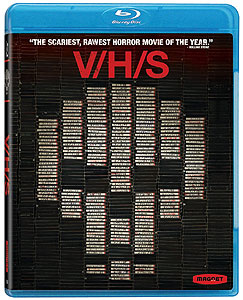
V/H/S is possibly the first found-footage horror anthology, two styles of filmmaking that are loved as much as they are hated. Found footage films are, without a doubt, one of the biggest cultural trends of the last decade and as such, can go either very well or horribly awry. Anthologies are another risky venture for horror films as inevitably there will be one or two segments which don’t measure up to the rest, thus rendering the entire project grievously flawed. These issues do plague V/H/S to a certain extent, but as an experimental indie horror film, it’s still a success.
The wraparound story of V/H/S (“Tape 56,” written by Simon Barrett, directed by Adam Wingard) is certainly creepy, but still off putting in the way it posits the main characters as disgusting losers. Our introduction to them is footage of their restraining a woman in a parking garage and filming her naked breasts as they pull off her shirt and later, trashing the hell out of an abandoned house. They do this for money but we get the idea that they’d probably do it for free, too. We next learn they’ve been hired to break into a house and steal one VHS tape, having been told “you’ll know it when you see it.” This makes sense within the context of the wraparound segment, but it doesn’t endear us to them one bit. In fact, I found myself pretty repulsed by the intro and wondered if I could even make it through the rest of the film.
Toronto After Dark 2012: Resolution Review
Published on October 24th, 2012 in: Canadian Content, Comedy, Film Festivals, Found Footage, Movie Reviews, Movies, Reviews |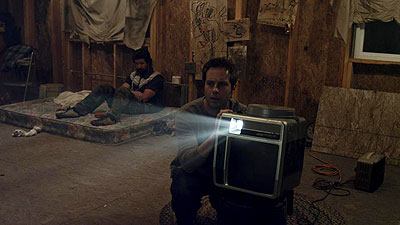
Perhaps more than any other movie I’ve seen this year, Resolution will be the hardest to explain or describe. It’s not necessarily for fear of spoilers, because even if I wrote out the entire plot in detail it would probably 1) reduce the movie to some kind of gibberish and 2) not actually ruin anything because the joy of Resolution is all in the experience of watching it.
The King and (F.B.)I: Elvis Found Alive
Published on January 30th, 2012 in: Documentaries, DVD, DVD/Blu-Ray Reviews, Found Footage, Issues, Movies, Oh No You Didn't, Reviews |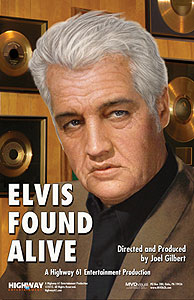
Elvis Presley is alive and well and living in Simi Valley. Or at least that’s the claim of Elvis Found Alive, a new faux-documentary from Highway 61 Entertainment, who brought you Paul McCartney Is Really Dead: The Last Testament of George Harrison (reviewed here). This time around, they’re doing a complete 180, revealing a conspiracy to fake a death instead of a life.
Catfish: Beyond Real And Beyond Fake
Published on January 30th, 2012 in: Documentaries, Found Footage, Issues, Media, Movie Reviews, Movies, Oh No You Didn't, The Internets |Living on the Internet means that you often have to dodge spoilers. Luckily, the Internet is also so crammed with information there are enough things with which to distract yourself.
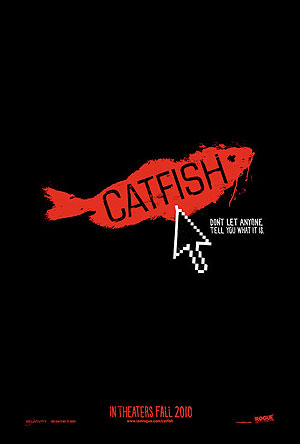
Such was the case with Catfish, a 2010 documentary that caught my attention via its unsettling trailer, which seemed like a faux documentary horror movie along the lines of The Blair Witch Project or the Paranormal Activity series. It was clear that an appreciation of the film was a case of “less is more,” so I added it to my DVD queue and successfully avoided spoilers for almost two years.
When I finally watched Catfish earlier this week, my stomach was in knots for at least 45 minutes until the movie completely . . . I’ll stop here because if you haven’t seen Catfish, you should watch it, and you should watch it not knowing any more than I did.
Catfish is a remarkable film and one that is thrilling, upsetting, disturbing, and moving. It makes incredible use of technology in its presentation of the Internet persona through GPS, Google, YouTube, Facebook, and all the other forms of social and searchable media we use every day. Such technology is so easily accessible and so widely used that it becomes a part of our lives that we take for granted, even though we assign it so much importance. We take all the veracity it reveals to us on faith.
As far as Internet personas, it’s common knowledge that we want to show everyone the best of ourselves, even if that means we make ourselves seem better than we are. But there is always a gap between our “real” selves and our Internet selves.
The width of this gap will likely determine how you treat your Internet friends. Do you treat them the same as your “real life” friends? Better? Worse? Do you subscribe to the “It’s just the Internet” theory to make yourself feel better about what you see and read there? The width of this gap will also determine how much Internet interactions affect you when you’re not on the Internet.
These were the ideas swirling around in my head right after I watched Catfish and right before I started looking up reviews online. Then, much like the film itself, everything changed. SPOILERS BEHIND THE CUT!
Jesus Take The (Lunar) Wheel: Apollo 18
Published on September 29th, 2011 in: Found Footage, Halloween, Horror, Movie Reviews, Movies, Reviews, Science and Technology, Science Fiction |By Emily Carney
On July 20, 1969, Apollo 11’s lunar module Eagle landed on Earth’s Moon, beginning three years of unsurpassed, spectacular lunar voyages.
On December 14, 1972, Apollo 17’s lunar module Challenger departed the Moon’s surface, leaving a massive void in manned lunar exploration which continues to exist until the present time.
In the beginning of the 1960s, President John F. Kennedy sent out a resounding, powerful call to have a man walk on the Moon by the end of that decade, and NASA was wholly successful in their goal to meet such a momentous deadline.
It took Hollywood well over 50 years from that point to make Apollo 18. To paraphrase JFK, at the beginning of this decade, we made the worst space horror film, ever.
(more…)
